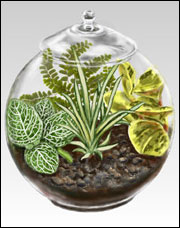Making Your Own Terrariums
Kent Kobayashi
Tropical Plant & Soil Sciences Dept.
College of Tropical Agriculture & Human Resources
University of Hawaii at Manoa
INTRODUCTION
A terrarium is a clear glass or plastic container filled with plants and/or small animals (frogs, turtles, or lizards). They resemble miniature gardens. Terrariums are attractive and easy to care for--just plant it and forget it. And because a terrarium recycles its water, it need very little attention.

MATERIALS NEEDED
All you need to build a simple terrarium:
- Container. Any clear glass or plastic container can be used. Fish tanks (aquariums) and brandy snifters make attractive displays. Fish bowls, jars, and bottles are commonly used.
If the container does not come with a lid, a sheet of clear plastic or glass makes a suitable cover. Small openings in the top of the container may require water be added periodically. Containers with large openings or without covers can be used, but will require more frequent watering.
- Plants. Many plants do well in terrariums. Choose the ones that fit the size of the container. Plants that have a low and dense growth habit are best. Most plants recommended for terrariums are moisture-loving types which never become large.
Choose plants with similar requirements for water, light, and temperature. Slower growing plants require less trimming. Miniature flowering plants fit particularly well into terrarium arrangements.
- Media. The growing media must be clean, well drained, and high in organic matter. Potting soils sold at garden shops are sterile and ready for use. Prepackaged peat-like mixes are also excellent choices.
- Tools. Only a few tools are necessary for planting a terrarium. Long sticks are used to dig holes, move items, and support plants while they are being planted. Household scissors will help in pruning plants before they are planted. A large kitchen spoon is used to place soil and drainage material in the container. An atomizer or bulb-type sprayer is useful for watering the terrarium.
- Accents. Rocks, pebbles, and other natural materials are pleasing accents in terrariums. Bark, sticks, wood, or ceramic figures are other possible choices. Avoid too many accessories, or those with vivid, unnatural colors.
STEPS
Before beginning your terrarium, decide whether you prefer a tropical, woodland, or desert theme. Keep in mind the temperature and light conditions in the location where you plan to place the terrarium. Select plants that are suitable for that location.
- A drainage layer is essential to ensure roots are not sitting in excess moisture. Place a 1/2 to 1-inch layer of small gravel or pebbles in the bottom. Add a layer of sphagnum moss. This serves to keep soil from seeping into the drainage layer.
- Sprinkle crushed charcoal in the bottom to keep the soil fresh. This keeps odors from developing.
- Add 1/2 to 1 inch of well draining, fertile potting soil. If the soil clumps when squeezed, add perlite or vermiculite to add texture and porosity. You may wish to landscape the soil by adding little mounds and depressions in the soil.
- Dig small holes in the soil and place the plants in them, making sure all roots are in the hole. Firm the soil gently around the roots.
- Avoid clutter. Often a simple arrangement with a few well-placed, attractive plants are much more pleasing to the eye. Space should be left between plants to allow them room to grow and to facilitate air circulation.
If the terrarium will be viewed from only one side , place the larger plants in the back. If it will be seen from all sides, the larger plants should be placed near the center, surrounded by the smaller plants.
- Water lightly if needed. After covering the terrarium, place it in a shaded area until the plants become re-established. Watch carefully for a few days. If water condenses heavily on the inside the container, remove the lid so the excess moisture can evaporate. If the plants wilt and no condensation forms, add a small amount of water.
MAINTENANCE
Closed terrariums. A closed terrarium requires a minimum of care if it is kept sealed. It typically does not need to be watered because plants recycle the moisture they use. Water lightly only if it gets dry. Open the lid only to allow excess moisture to escape.
Open terrariums. The open terrarium requires more frequent watering, but there is less disease buildup.
General. Place the terrarium in a bright location, but not in direct sunlight. A little direct sunlight can cause temperatures in an sealed terrarium to rise rapidly.
Remove any dead plants and leaves. Prune back excessive growth as needed. When a plant gets as big as you want, pinch it back to encourage bushier growth.
Adding fertilizer is generally not necessary since the plants should not grow rapidly. Good potting soil should contain enough nutrients. Over time, the soil can be "refreshed" by scraping off the top layer of soil and adding some fresh potting soil. This will add a small amount of nutrients. If the leaves begin to yellow after a few months, add a little water soluble fertilizer.
Require little attention, terrariums will grow successfully on their own for several years.
Links
Make Your Own Terrarium, do it yourself network
Terrariums, Home & Garden Television
Top of page
K. Kobayashi's main page

